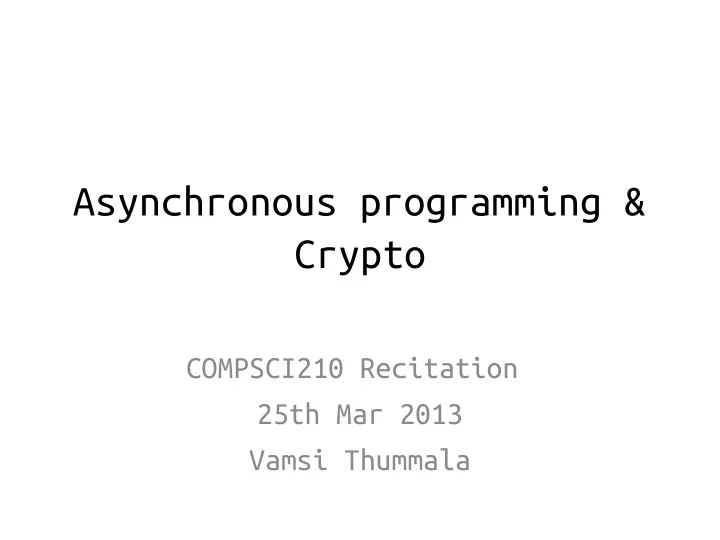

Asynchronous programming & Crypto COMPSCI210 Recitation 25th Mar 2013 Vamsi Thummala
Reminder on Java synchronized • Combines: a lock and a CV • In your Elevator, if you implement EventBarrier correctly, you only need locking, but not a CV – Java does not provide a way to do that directly – Locks are in turn implemented using “synchronized” as a library – java.util.concurrent.locks – Restricted for Elevator lab
java.util.concurrent • Lock • Thread safe collections – HashMap, Queue, and .. • Semaphore • CyclicBarrier • ExecutorService – Thread pool • FutureTask
Thread pooling import java.util.concurrent.ExecutorService; public class SumFirstN implements Runnable { import java.util.concurrent.Executors; private final int _N; public class Main { private static final int NTHREDS = 10; SumFirstN(int N) { _N = N; public static void main(String[] args) { } ExecutorService executor = Executors.newFixedThreadPool(NTHREDS); @Override for (int i = 0; i < 500; i++) { Runnable worker = new SumFirstN(i); public void run() { executor.execute(worker); long sum = 0; } for (int i = 1; i < _N; i++) { executor.shutdown(); // Do not accept any more sum += i; threads } // Wait until all threads are finish System.out.println(sum); while (!executor.isTerminated()) { } } } } }
What if each task is an IO or a network call? • May take arbitrary amount of time to complete • Each thread submit a task and just waits! • Waste of resources
Asynchronous call • Similar interface as Runnable public class CallBackTask implements Callable { public void call() { } }
Using Callable import java.util.concurrent.ExecutorService; public class SumFirstN implements Callable { import java.util.concurrent.Executors; private final int _N; public class Main { private static final int NTHREDS = 10; SumFirstN(int N) { _N = N; public static void main(String[] args) { } ExecutorService executor = Executors.newFixedThreadPool(NTHREDS); @Override for (int i = 0; i < 500; i++) { Callable worker = new SumFirstN(i); public void call() { executor.execute(worker); long sum = 0; } for (int i = 1; i < _N; i++) { executor.shutdown(); // Do not accept any more sum += i; threads } // Wait until all threads are finish System.out.println(sum); while (!executor.isTerminated()) { } } } } }
What if we expect a result from a callback? • Typically, a read on disk • A Future can capture the result of an asynchronous computation Future<Long> sum = executor.submit(new Callable<Integer>()
Using Callable with Future import java.util.concurrent.ExecutorService; public class SumFirstN implements import java.util.concurrent.Executors; Callable { private final int _N; public class Main { private static final int NTHREDS = 10; List<Future<Long>> list = new ArrayList<Future<Long>>(); SumFirstN(int N) { public static void main(String[] args) { _N = N; ExecutorService executor = Executors.newFixedThreadPool(NTHREDS); } for (int i = 0; i < 500; i++) { Callable worker = new SumFirstN(i); @Override Future<Long> sW = executor.execute(worker); list.add(sW); public Long call() { } long sum = 0; // Now retrieve the result for (int i = 1; i < _N; i++) { for (Future<Long> future : list) { long sum = future.get(); // ignored the try/catch block sum += i; } } executor.shutdown(); // Do not accept any more threads // Wait until all threads are finish return sum; while (!executor.isTerminated()) { } } } } }
Asynchronous programming • Event driven – Awaiting for IO – Awaiting for input for network – Awaiting for input from user • GUI, Mobile device (Android) • Java Future library – Primitive but powerful stuff – More native support in other languages • You will be doing callbacks in Lab4
Crypto: Concept checkers • What is the basic assumption that cryptography relies on? • What is a hash/finger print/digest? • What is a digital signature? • Symmetric vs Asymmetric crypto • What is a nonce? • What is a security/treat model? • Type of attacks and defenses
Crypto: Q from past midterm “Cryptographic hash functions (also called secure hashing or SHA) are useful even if the result digest (also called a hash or fingerprint) is not encrypted, as it is with digital signatures. For example, if Alice knows a secret, and passes Bob a digest of the secret, then Bob can determine if another party also knows the secret, even without knowing the secret himself.”
Symmetric and Asymmetric Crypto: Better Together • Use asymmetric crypto to “handshake” and establish a secret session key (slow, but allows for key distribution). • Then use the key to talk with symmetric crypto (fast and cheap) • Example: Secure Sockets Layer (SSL) or Transport-Layer Security (TLS), used in HTTPS (Secure HTTP), SSH, SCP, etc. “SYN, etc.” “My public key is K.” “Let’s establish a session key: {S}K .” Server Client {M}S [encrypted data or content] …
Recommend
More recommend